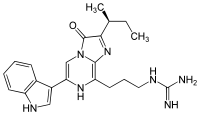Vargulin
 | |
| Names | |
|---|---|
| IUPAC name
2-[3-[2-[(2S)-butan-2-yl]-6-(1H-indol-3-yl)-3-oxo-7H-imidazo[2,
1-c]pyrazin-8-yl]propyl]guanidine | |
| Other names
Vargulin, Cypridina luciferin, cypridinid luciferin | |
| Identifiers | |
3D model (JSmol) |
|
| ChemSpider | |
PubChem CID |
|
| |
| |
| Properties | |
| C22H27N7O | |
| Molar mass | 405.496 |
Except where otherwise noted, data are given for materials in their standard state (at 25 °C [77 °F], 100 kPa). | |
| Infobox references | |
Vargulin, also called Cypridinid luciferin, Cypridina luciferin or Vargula Luciferin, is the luciferin found in the ostracod Cypridina hilgendorfii, also named Vargula hilgendorfii.[1] These bottom dwelling ostracods emit a light stream into water when disturbed presumably to deter predation. Vargulin is also used by the midshipman fish, Porichthys.
History
A partial extraction procedure was developed in 1935 which involved reacting the compound with benzoyl chloride to allow it to be separated from the water-soluble components.[2] The compound was first isolated and purified to crystals by Osamu Shimomura.[3] The structure of the compound was confirmed some years later.[4] Feeding experiments suggest that the compound is synthesized in the animal from three amino-acids: tryptophan, isoleucine, and arginine.[5]
Biochemistry
Vargulin is oxidized by the Vargula luciferase,[6] a 62kDa enzyme, to produce blue light at 462 nm (max emission, detected with a 425 to 525 nm filter). The vargulin does not cross react with luciferases using Coelenterazine or Firefly luciferin.
Uses
Vargulin (with the associated luciferase) has applications in Biotechnology:
- in a variety of assays, to report gene or gene expression after luciferase have been genetically introduced in cells,
- to detect ATP, that is used in the vargulin/luciferase reaction (cell viability assays)
Although less stable, the Cypridina system is useful because can be used in multiplex assays with other (red-emitting) luciferin assays.
References
- ↑ Shimomura, O. (2006). Bioluminescence: Chemical Principles and Methods. World Scientific Publishing. ISBN 978-981-256-801-4.
- ↑ Anderson, RS (1935). "Studies on Bioluminescence : II. the Partial Purification of Cypridina Luciferin". The Journal of General Physiology. 19 (2): 301–5. doi:10.1085/jgp.19.2.301. PMC 2141430. PMID 19872927.
- ↑ Shimomura, O; Goto, T & Hirata, Y (1957). "Crystalline Cypridina Luciferin". Bulletin of the Chemical Society of Japan. 30 (8): 929–933. doi:10.1246/bcsj.30.929.
- ↑ Kishi Y, Goto; T, Hirata Y; Shiromura O & Johnson FH (1966). "Cypridina bioluminescence. I. Structure of Cypridina luciferin". Tetrahedron Lett. 7 (29): 3427&ndash, 3436. doi:10.1016/S0040-4039(01)82806-9.
- ↑ Oba, Y; Kato, S; Ojika, M & Inouye, S (2002). "Biosynthesis of luciferin in the sea firefly, Cypridina hilgendorfii: l-tryptophan is a component in Cypridina luciferin". Tetrahedron Letters. 43 (12): 2389–2392. doi:10.1016/S0040-4039(02)00257-5.
- ↑ Thompson EM, Nagata S, Tsuji FI (1989). "Cloning and expression of cDNA for the luciferase from the marine ostracod Vargula hilgendorfii". Proceedings of the National Academy of Sciences. 86 (17): 6567–71. doi:10.1073/pnas.86.17.6567. PMC 297885. PMID 2771943.